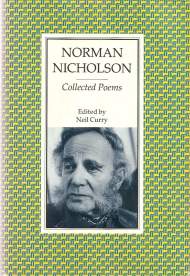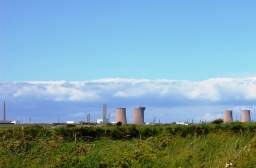

Articles
"Verse Rooted Like a Tree"
The Cumbrian Poetry of Norman Nicholson
by David Boyd

Norman Nicholson's intellectual and literary talent soared far beyond the isolated iron-smelting town in which he lived for most of his life: An accomplished English prose writer and journalist he developed into arguably the best poet from the Lake District of England since Wordsworth. He was deeply influenced by the work of T. S. Eliot, who applauded Nicholson's poetry and published it through his London firm of Faber and Faber. Nicholson became one of the select band of 'Faber Poets' which included W. H. Auden, Louis MacNeice, Sylvia Plath, Ted Hughes and Philip Larkin.
A Distinguished Reputation
As a young man Nicholson became celebrated in his hometown and throughout England as a virtuoso broadcaster and public speaker. But it is for his mature poetry that Nicholson is remembered. Between Comets, a collection of tributes written to celebrate his 70th birthday, includes entries from Seamus Heaney, Ted Hughes, R.S. Thomas, Philip Gardner, Melvyn Bragg and many others.
Seamus Heaney
"A Paved Text"
For Norman Nicholson
...those Cumbrian phonetics
cracked like a plaited whip
until the slack, nostalgic
ambler in me trotted
on the paved margin
of my own black pool—
Dublin black pool, dubh linn
...that is yours and mine as well
David Wright
"To Norman Nicholson"
And then there's Ravenglass, and the bird-haunted
Sand-dunes lagooning a derelict sea.
This, Norman, is your country and your home,
And where your verse lives rooted like a tree...
Other tribute poems include Ted Hughes' "A Tern for Norman Nicholson."
"The Waste Land" when first published in 1922 excited the young Nicholson's poetic ambition. He described the experience of this modernist poem as being 'like a religious conversion.' So pervasive was the influence of Eliot and that of W. H. Auden, more Nicholson's contemporary, that he did not develop his own unique and confident poetic 'voice' until he was in his 30s. Nicholson described himself, somewhat mischievously, as a 'modern' but not a 'modernist' poet, who liked 'a beginning and an end' to his poems. Aware that Eliot's poetry was both masterful and inspirational he deliberately avoided imitating the older poet's style.
Nicholson and Eliot both enjoyed a friendship with Brother George Every, an Anglican monk, teacher, historian and writer, of the Society of the Sacred Mission at Kelham near Nottingham, where Eliot regularly took spiritual retreats. This location and Brother Every's influence were among the inspirations for Eliot's poem "Little Gidding," incorporated into his "Four Quartets." From Eliot, Nicholson learned Modernist means of expressing his lifelong religious faith.
Wordsworth was a similar pervasive influence, but Nicholson's experience of Cumbria was perhaps more class-conscious than the former poet's, whose ghost stalked both the exquisite Lake District landscape of Cumbria and the creative consciousnesses of most English-speaking poets who succeeded him. Nicholson acknowledged Wordsworth as the author of some of the finest poetry ever written in the English language but also saw his work as limited to the privileged experiences of upper middle-class life. In "To The River Duddon" Nicholson ambitiously offered an irreverent riposte to Wordsworth, who had taken the Cumbrian river as a subject in his much-admired 'Duddon Sonnets.'
I wonder, Duddon, if you still remember
An oldish man with a nose like a pony's nose
Broad bones, legs long and lean but strong enough
To carry him over Hardknott [a mountain pass] at seventy years of age.
He came to you first as a boy with a fishing-rod
And a hunk of Ann Tyson's bread and cheese in his pocket,
Walking from Hawkshead across Walna Scar;
Then as a middle-aged Rydal landlord,
With a doting sister and a pension on the civil [ie Government] list,
Who left his verses gummed to your rocks like lichen,
The dry and yellow edges of a once-green spring.
Social and Environmental Concerns
Always a champion of the working class, Nicholson had become a lecturer for the local Workers' Educational Association, a national charity aimed at ameliorating through education the lives of ordinary working people. This post led to others; he taught English literature at locations that required him to travel on the coastal railway line, inspiring poems like this one about his rail journey along the West Cumbria coastline to Whitehaven which runs alongside and through estuaries and a region containing vast deposits of blood-red haematite iron ore, extensively mined in the 19th and early 20th centuries.
Southward from Whitehaven where cliffs of coal
Slant like shale to the low black mole.
The railway canters along the curving shore
Over five rivers which slowly pour
On the slopes of the shingle where the grey gulls bask
... ...
The EHEN twists and flicks its fin
Red as rhubarb beneath the grey skin
For its veins are stained with the blood of the ore
Of the mines of Egremont and Cleator Moor...
Iron-smelting, which had been the single industry and very lifeblood of his hometown unexpectedly closed down in 1968, provoking indignant verse from Nicholson as in "On the Dismantling of Millom Ironworks":
.....They cut up the carcass of the old ironworks
Like a fat beast in a slaughter-house: they shovelled my childhood
On to a rubbish heap. Here my father's father,
Foreman of the back furnace, unsluiced the metal lava
To slop in fiery gutters across the foundry floor
And boil round the workmen's boots....
Adopted by 'The Greens'
Norman Nicholson's reputation languished following his death in 1987; most of his books were long out of print and his work seemed to be consigned to the list of the 'also-rans' of twentieth-century English poetry, while contemporaneous writers such as Betjeman, Larkin and Ted Hughes continued to be feted. Only now is his work being re-discovered and celebrated beyond the confines of his locale. A recently formed 'Norman Nicholson Society' now flourishes in Millom, where the façade of his modest home displays a commemorative blue plaque and the town's Folk Museum has galleries devoted to his life and work. Some of his poems have had much nationwide exposure as 'set texts' for school English Literature curricula and his indignant, vehemently-scathing anti-nuclear poem 'Windscale,' provoked by a catastrophic local nuclear reactor fire and Chernobyl-like radioactive fallout in 1957, has become the anthem of groups of 'greens' and others opposed to atomic power and other nuclear processes.
The toadstool towers infest the shore:
Stink-horns that propagate and spore
Wherever the wind blows... ....
This is a land where dirt is clean,
And poison pasture quick and green,
And storm sky, bright and bare;
Where sewers flow with milk, and meat
Is carved up for the fire to eat,
And children suffocate in God's fresh air.
A seminar including many eminent UK academics, poets and literary critics held recently by The University of Lancaster examined in detail Norman Nicholson's unique relationship with the English Lake District and the West Cumbrian landscapes. Brian Whalley, Professor of Geology at Belfast's Queen's University has found Nicholson's writings still so remarkably and very accurately descriptive of Cumbrian geomorphology that he uses them as teaching aids in his university geology courses.
Yet twenty years after his death, there exists neither any comprehensive biography nor any full critical assessment of his literary life and achievement, a deeply yawning gap in England's literary heritage which remains to be adequately bridged.
David Boyd, a lifelong native of Cumbria, England, is writing a biography of Norman Nicholson.
